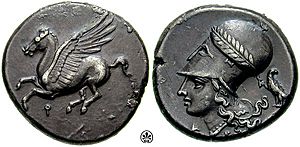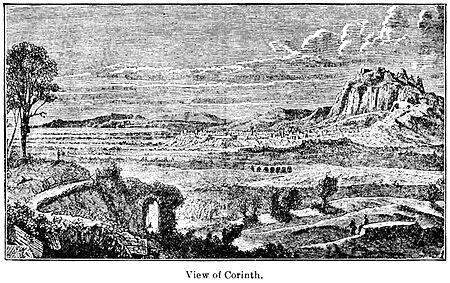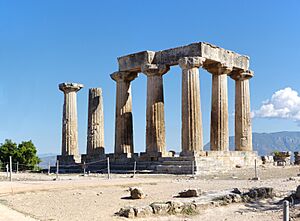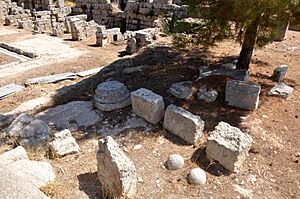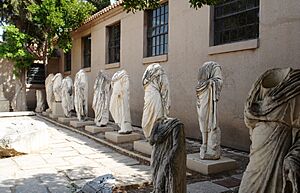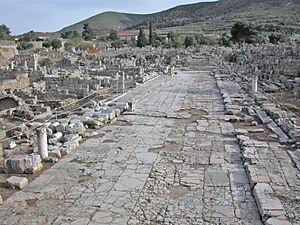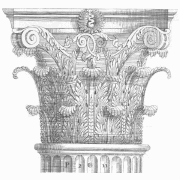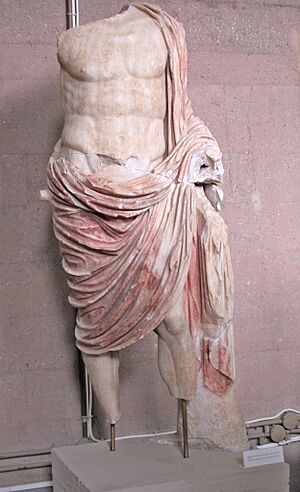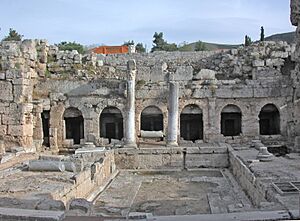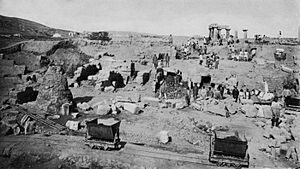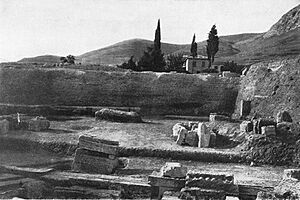Ancient Corinth facts for kids
Quick facts for kids
Corinth
Κόρινθος
Ϙόρινθος |
|||||||||
|---|---|---|---|---|---|---|---|---|---|
| 900 BC–146 BC | |||||||||
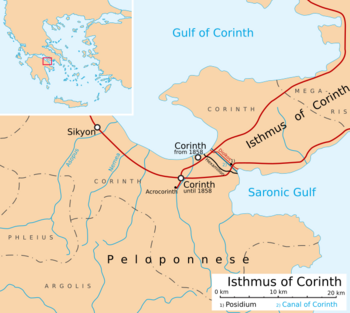
Map of ancient Corinth
|
|||||||||

Reconstruction of the city of Corinth
|
|||||||||
| Capital | Corinth | ||||||||
| Common languages | Doric Greek | ||||||||
| Religion | Hellenism | ||||||||
| Government | Oligarchy | ||||||||
| Historical era | Classical Antiquity | ||||||||
|
• Founding
|
900 BC | ||||||||
|
• Cypselus
|
657–627 BC | ||||||||
| 146 BC | |||||||||
|
|||||||||
Corinth (British English: /ˈkɒrɪnθ/ KORR-inth, American English: /ˈkɔːrɪnθ/; Greek: Κόρινθος Korinthos; Doric Greek: Ϙόρινθος; Latin: Corinthus) was an important city-state in ancient Greece. It was located on the Isthmus of Corinth, a narrow strip of land connecting the Peloponnese peninsula to mainland Greece. This spot was perfect for trade, as it was roughly halfway between Athens and Sparta.
Today, the modern city of Corinth is about 5 kilometres (3.1 mi) northeast of the ancient ruins. Since 1896, archaeologists from the American School of Classical Studies at Athens have been digging up and studying the ancient city. They have found many amazing parts of old Corinth.
For Christians, Corinth is famous because of two letters written by Saint Paul in the New Testament. These are called First and Second Corinthians. The city is also mentioned in the Acts of the Apostles, which describes Paul's travels.
Ancient Corinth was one of the biggest and most important cities in Greece. Around 400 BC, it had about 90,000 people. The Romans destroyed Corinth in 146 BC. But they built a new city in its place in 44 BC, and it later became the capital of the Roman province of Greece.
Contents
- History of Ancient Corinth
- Ancient City and Its Surroundings
- Archaeological Excavations
- Modern Corinth
- Important Monuments
- Notable People
- In Literature
- See Also
History of Ancient Corinth
Early Times and Myths
People lived in the area of Corinth as early as 6500 BC, during the Neolithic period. Pottery found there shows that it was a trading center in the Early Bronze Age. However, the area was not heavily populated again until around 900 BC, when the Dorians settled there.
According to myths, the city was founded by Corinthos, a descendant of the god Zeus. Other stories say it was founded by the goddess Ephyra, a daughter of the Titan Oceanus. This is why the city was also called Ephyra.
It's believed that Corinth was once a Mycenaean palace-city, similar to Mycenae or Pylos. In myths, Sisyphus was a king of Corinth. It was also in Corinth that Jason, the leader of the Argonauts, left Medea. The city and its people are even mentioned in the Iliad, fighting in the Trojan War.
One Corinthian myth tells of a disagreement between Poseidon, god of the sea, and Helios, god of the sun. Briareus, a giant with a hundred hands, decided that the Isthmus of Corinth (the land near the sea) belonged to Poseidon. The high hill of Corinth, called Acrocorinth, belonged to Helios.
The Upper Peirene spring is on the Acrocorinth hill. Legend says the winged horse Pegasus drank from this spring. The Corinthian hero Bellerophon then captured and tamed Pegasus there.
Corinth Under the Bacchiadae Family
In the 8th and 7th centuries BC, Corinth was ruled by a powerful family called the Bacchiadae. They were a tight-knit group who took power from the last king around 747 BC. Instead of a king, they ruled as a group. They elected a leader called a prytanis each year and a polemarchos to lead the army.
During their rule (747 to 650 BC), Corinth grew into a strong, unified state. Big public buildings and monuments were built. In 733 BC, Corinth started new settlements, or colonies, in places like Corcyra and Syracuse. By 730 BC, Corinth was a very advanced Greek city with at least 5,000 people.
The Bacchiadae's rule ended in 657 BC. The military leader, Cypselus, believed an oracle from Delphi meant he should rule. He then took power and sent the Bacchiadae family away.
Corinth Under the Tyrants
Cypselus was the first tyrant of Corinth. A tyrant in ancient Greece was a ruler who took power, often by force, but wasn't necessarily cruel. Cypselus ruled from 658–628 BC. He removed the Bacchiad family from power and ruled for 30 years. He built temples to Apollo and Poseidon around 650 BC.
Cypselus was the son of Eëtion and a woman named Labda. According to Herodotus, the Bacchiadae family heard a prophecy that Labda's son would overthrow them. They tried to kill baby Cypselus, but he smiled at them, and they couldn't do it. Labda then hid him in a chest, saving his life. This famous chest, made of ivory and gold, was later displayed at Olympia.
Cypselus grew up and became the ruler, just as the prophecy said. He was popular and ruled fairly, unlike many later tyrants. He didn't even need bodyguards and died peacefully.
Under Cypselus and his son Periander, Corinth sent out many colonists to start new settlements. These included places like Epidamnus (modern-day Durrës in Albania) and Syracuse in Sicily. Corinth was also one of nine Greek cities that helped found Naukratis in Ancient Egypt. This city helped with trade between Greece and Egypt.
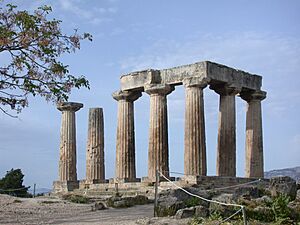
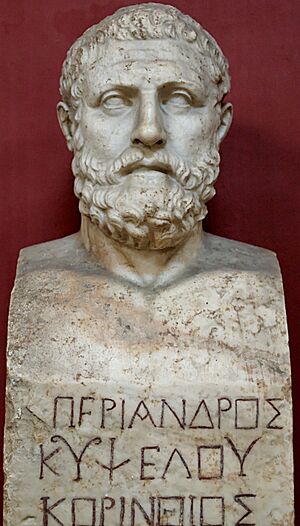
Cypselus was followed by his son Periander in 627 BC. Periander was considered one of the Seven Wise Men of Greece. During his time, Corinth made its first coins. He also tried to dig a canal across the Isthmus to connect the two gulfs, but it was too difficult. Instead, he built the Diolkos, a stone ramp where ships could be pulled overland. This period was Corinth's "golden age."
Periander's rule ended with his nephew, Psammetichus, who was named after an Egyptian Pharaoh.
Corinth After the Tyrants
- 581 BC: Periander's nephew was killed, ending the rule of tyrants.
- 581 BC: The Isthmian Games, a major athletic and religious festival, were started by leading families.
- 570 BC: People in Corinth began using silver coins called 'colts' or 'foals'.
- 550 BC: The famous Temple of Apollo was built.
- 550 BC: Corinth became an ally of Sparta.
Before the classical period, Corinthians developed the trireme, a powerful warship. This ship became the standard warship in the Mediterranean for a long time. Corinth fought the first recorded naval battle against the city of Corcyra. Corinth was also known for its wealth because of its location. All land trade between mainland Greece and the Peloponnese had to pass through the Isthmus.
Classical Corinth

In classical times, Corinth was as wealthy as Athens and Thebes. Its wealth came from trade and traffic across the Isthmus. Until the mid-6th century BC, Corinth was a big exporter of black-figure pottery to other Greek cities.
Corinth also had a famous temple of Aphrodite, the goddess of love. The city was known for its luxurious lifestyle. The saying "Not everyone is able to go to Corinth" meant that its luxuries were too expensive for everyone.
Corinth was also home to the Isthmian Games, one of the four Panhellenic Games. During this time, Corinthians created the Corinthian order, a style of architecture. It was the most detailed and fancy of the three main Greek styles (Doric, Ionic, and Corinthian). This showed the city's wealth and love for luxury.
The city had two main ports. Lechaion was on the Corinthian Gulf to the west. It connected Corinth to its western colonies and Magna Graecia (Greek settlements in Italy and Sicily). Kenchreai was on the Saronic Gulf to the east. It served ships coming from Athens, Ionia, and the Middle East. Both ports had docks for Corinth's large navy.
In 491 BC, Corinth helped settle a dispute between Syracuse and Gela in Sicily.
During the Greco-Persian Wars (481–480 BC), Corinth joined other Greek cities to fight against Persia. Corinth sent 400 soldiers to defend Thermopylae and 40 warships to the Battle of Salamis. They also sent 5,000 soldiers with their special Corinthian helmets to the Battle of Plataea.
Some historians say that Corinthians were considered the second-best fighters after the Athenians.
Peloponnesian War
In 435 BC, Corinth and its colony Corcyra went to war. In 433 BC, Athens allied with Corcyra against Corinth. This dispute was one of the reasons for the Peloponnesian War, a major conflict between Athens and Sparta.
The people of Syracuse asked Corinth and Sparta for help against an Athenian invasion. Corinth quickly agreed to help them. They also convinced Sparta to send troops.
In 404 BC, Sparta refused to destroy Athens, which made Corinth angry. Corinth then joined Argos, Boeotia, and Athens to fight against Sparta in the Corinthian War.
Corinthian War
In 395 BC, after the Peloponnesian War, Corinth and Thebes were unhappy with Sparta's power. They decided to support Athens against Sparta in the Corinthian War.
From 379 BC to 323 BC
In 379 BC, Corinth switched sides again and joined Sparta in an attempt to defeat Thebes and take over Athens.
The city-states of Greece became weaker due to these conflicts. This prepared the way for the conquests of Philip II of Macedon.
In 338 BC, after defeating Athens and its allies, Philip II created the League of Corinth. This league united Greece (including Corinth and Macedonia) to fight against Persia. Philip was named the leader of the League.
Hellenistic Period
By 332 BC, Alexander the Great controlled Greece as the leader.
During the Hellenistic period, Corinth often lost its independence. It became a battleground for different powerful kingdoms that emerged after Alexander the Great's death. In 308 BC, Ptolemy I captured the city, claiming to free Greece. However, Demetrius recaptured it in 304 BC.
Corinth remained under Macedonian control for about 50 years. In 243 BC, Aratus of Sicyon launched a surprise attack and captured the fortress of Acrocorinth. He convinced the citizens to join the Achaean League, a group of Greek city-states.
The Macedonians briefly regained Corinth in 224 BC. But after the Romans got involved in 197 BC, Corinth permanently joined the Achaean League. Under the leadership of Philopoemen, the Achaeans took control of the entire Peloponnese, and Corinth became their capital.
Roman Era
In 146 BC, Rome declared war on the Achaean League. The Roman army, led by Lucius Mummius, attacked, captured, and burned Corinth. Mummius killed all the men and sold the women and children into slavery. Corinth remained mostly empty until Julius Caesar rebuilt it in 44 BC, just before he was killed. At this time, a Roman amphitheater was built.
Under the Romans, Corinth was rebuilt as a major city in Southern Greece. It had a diverse population of Romans, Greeks, and Jews. The city was also important for the Roman imperial cult, which honored the Roman emperors.
Biblical Corinth
Corinth is mentioned many times in the New Testament, mostly because of Paul the Apostle's visits there. This shows how successful Caesar's rebuilding of the city was. It is believed that Paul founded the Christian church in Corinth.
The apostle Paul first visited Corinth around AD 49 or 50. He stayed there for 18 months (see Acts 18:11). Here, he met Priscilla and Aquila, who were tentmakers like him. They worked together and regularly attended the synagogue.
In AD 51/52, a Roman official named Gallio oversaw a trial of Paul in Corinth. This event helps historians date parts of the Acts of the Apostles in the Bible. Paul later wrote at least two letters to the Christian church in Corinth, the First Epistle to the Corinthians and the Second Epistle to the Corinthians. These letters sometimes show the challenges faced by the growing Christian church in a busy city like Corinth.
Some experts believe Paul visited Corinth a third time, which he called a "painful visit" (see 2 Corinthians 2:1). After writing his second letter, he stayed in Corinth for about three months and wrote his Epistle to the Romans.
Medieval Roman (Byzantine) Era
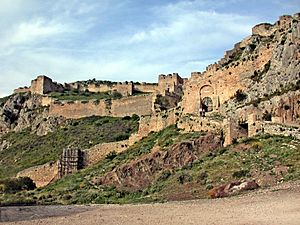
Corinth was greatly damaged by earthquakes in AD 365 and AD 375. Then, Alaric invaded in 396. The city was rebuilt on a grand scale, but it was much smaller than before. Four churches were built in the city, and another on the Acrocorinth citadel.
During the rule of Emperor Justinian I (527–565), a large stone wall was built across the Isthmus. This wall, called Hexamilion ("six-miles"), was about 10 kilometres (6.2 mi) long. It protected the city and the Peloponnese peninsula from invaders from the north.
Corinth declined from the 6th century onwards. The main settlement moved from the lower city to the Acrocorinth hill. The city began to recover in the 9th century. It reached its peak in the 11th and 12th centuries, becoming famous for its silk industry.
In November 856, a big earthquake in Corinth killed about 45,000 people.
In 1147, the city was attacked and plundered by the Italo-Normans from Sicily. They took many captives, especially silk weavers. Corinth never fully recovered from this attack.
Principality of Achaea
After the Fourth Crusade attacked Constantinople, Crusaders conquered the Peloponnese. The people of Corinth resisted the Frankish (French) conquest from their stronghold in Acrocorinth from 1205 until 1210. In 1210, the fortress fell to the Crusaders. Corinth then became part of the Principality of Achaea, ruled by the Villehardouins.
The Ottomans captured the city in 1395. The Byzantines of the Despotate of the Morea recaptured it in 1403.
Ottoman Rule
In 1458, five years after the Fall of Constantinople, the Turks of the Ottoman Empire conquered Corinth and its strong castle. The Ottomans renamed it Gördes. The Venetians captured the city in 1687 during the Morean War. It remained under Venetian control until the Ottomans took it back in 1715.
Independence
During the Greek War of Independence (1821–1830), the city was fought over by Greek and Ottoman forces. The city was officially freed in 1832. In 1833, Corinth was considered as a possible new capital for the newly formed Kingdom of Greece. This was because of its history and important location. However, Nafplio was chosen first, and then Athens.
Ancient City and Its Surroundings
Acrocorinth, the High City
Acrocorinth is the acropolis (high city) of ancient Corinth. It is a huge rock that was lived on and used as a fortress from ancient times until the early 1800s. Because of its natural shape, it was easy to defend. It was made even stronger with walls during the Byzantine Empire. It was later a fortress for the Franks, Venetians, and Ottoman Turks. Acrocorinth had a reliable water supply. Its fortress was the last line of defense in southern Greece because it controlled the isthmus of Corinth. This helped stop enemies from entering the Peloponnesian peninsula. Three walls were built to defend the hill. The highest point had a temple to Aphrodite, which later became a church and then a mosque. Today, Acrocorinth is one of the most important medieval castle sites in Greece.
Two Ports: Lechaeum and Cenchreae
Corinth had two important harbors. Lechaeum was on the Corinthian Gulf to the west. It was connected to the city by long walls about 3 kilometres (1.9 mi) long. Lechaeum was the main port for trade with Italy and Sicily. Cenchreae was on the Saronic Gulf to the east. It served trade with the Eastern Mediterranean. Ships could be moved between the two harbors using the diolkos, a stone ramp built by the tyrant Periander.
Archaeological Excavations
The Corinth Excavations by the American School of Classical Studies at Athens started in 1896 and are still going on today. The modern village of Ancient Corinth sits right on top of the ancient city. So, the main focus of the digs has been around the Temple of Apollo, which was built in the mid-6th century BC. This large monument has been visible since ancient times.
Archaeologists have uncovered much of the site. They have found remains from the Early Neolithic period (6500-5750 BC) all the way to modern times. Digs have also taken place outside the main village area. These include the Sanctuary of Demeter and Kore on the slopes of Acrocorinth, the Potters’ Quarter, and the Sanctuary of Asklepios. Finds from these excavations are kept in the Archaeological Museum of Ancient Corinth.
Modern Corinth
In 1858, an earthquake destroyed the village around the ruins of Ancient Corinth. This led to the building of the new city of Corinth about 3 km (1.9 mi) northeast of the ancient site.
Important Monuments
- Acrocorinth Sanctuary of Demeter and Kore
- Asklepieion of Corinth
- Basilica Julia (Corinth)
- Bema (Ancient Corinth) (later Church of Apostle Paul)
- Fountain of Glauke
- Peirene
- Roman Odeion at Corinth
- Sacred Spring of Corinth
- South Stoa
- Temple E at Corinth
- Temple of Apollo (Corinth)
Notable People
Ancient Greece
- Achaicus (1st century AD), Christian
- Adrian of Corinth (3rd century AD), Christian saint
- Archias (8th century BC), founder of Syracuse
- Desmon (8th century BC), athlete
- Dinarchus (4th century BC), speaker and writer
- Diocles (8th century BC), athlete
- Diogenes of Sinope, 4th century BC, a famous philosopher
- Eumelus (8th century BC), poet
- Euphranor (4th century BC), sculptor and painter
- Periander (7th century BC), one of the Seven Sages of Greece
- Quadratus (4th century AD), Christian saint
- Timoleon (4th century BC), statesman and general
- Xeniades (5th century BC), philosopher
- Xenophon (5th century BC), athlete
Medieval Times
- Cyriacus the Anchorite (5th century), Christian saint
- William of Moerbeke (13th century), first to translate Aristotle's works into Latin
In Literature
- Alcmaeon in Corinth, a play by Greek writer Euripides (405 BC)
- The Queen of Corinth, a play by English writer John Fletcher (1647)
See Also
 In Spanish: Antigua Corinto para niños
In Spanish: Antigua Corinto para niños


